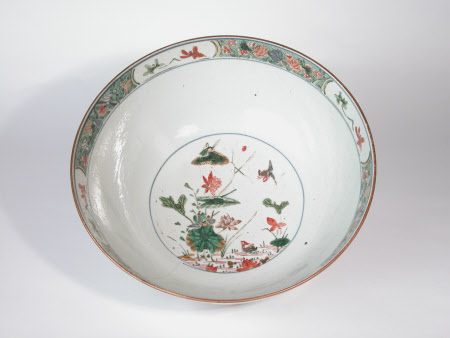Punch bowl
Category
Ceramics
Date
1700 - 1720
Materials
Porcelain, cobalt, enamel
Measurements
100 mm (Height); 250 mm (Diameter)
Place of origin
Jingdezhen
Order this imageCollection
Saltram, Devon
NT 870924
Summary
Punch bowl, porcelain, round, made in Jingdezhen, Jiangxi Province, China, Kangxi period (1662–1722), early 18th century, decorated in the famille verte (‘green family’) palette in underglaze blue and overglaze green, red, yellow, brown and blue enamels with various animals, plants and trees on the exterior with a band of stylised ribbons, leaves and flowers below the rim, and on the interior a vignette with lotus plants and ducks within a circular blue line and with a band of stylised flowers interspersed with cartouches with orchids.
Full description
Punch, a drink served in a large bowl to be drunk communally, came into vogue in late-17th-century Europe, influenced by the availability of sugar and spices through global trade and colonialism. The drink consisted of alcoholic spirits, water, sugar, lemon or lime and nutmeg and other spices. The name ‘punch’ appears to be derived from the Hindu panch or the Persian panji, meaning ‘five’, referring to the number of ingredients (Glanville and Young [eds.] 2002). A similarly decorated punch bowl was sold at Christie’s London, 23 August 2011, lot 14.
Provenance
Given to the National Trust by Montagu Brownlow Parker, 5th Earl of Morley (1878-1962), 1957.
References
Glanville and Young (eds.) 2002: Philippa Glanville and Hilary Young (eds.), Elegant Eating: Four Hundred Years of Dining in Style, London, 2002., p.106

